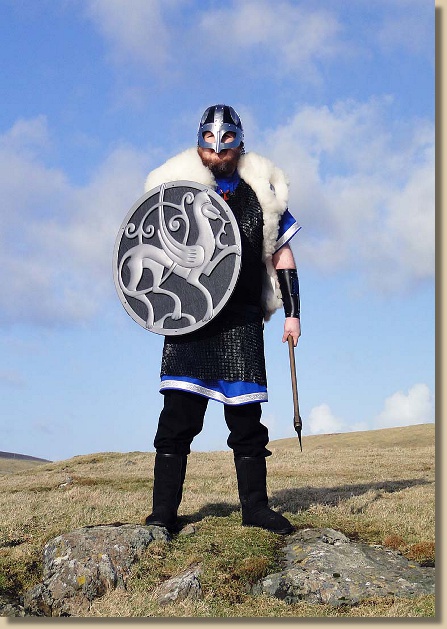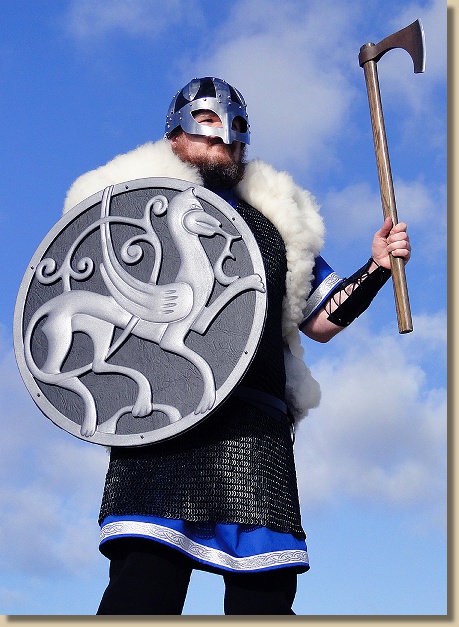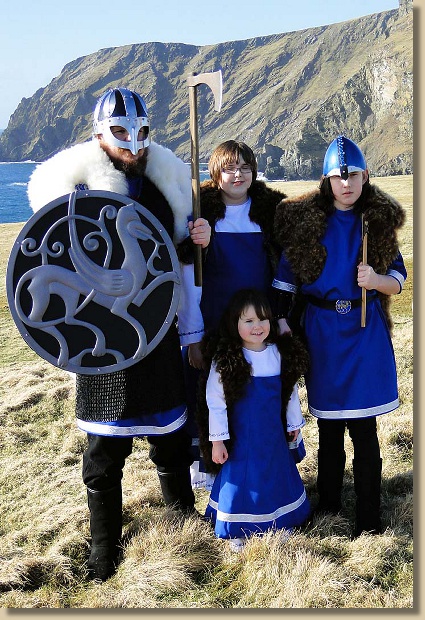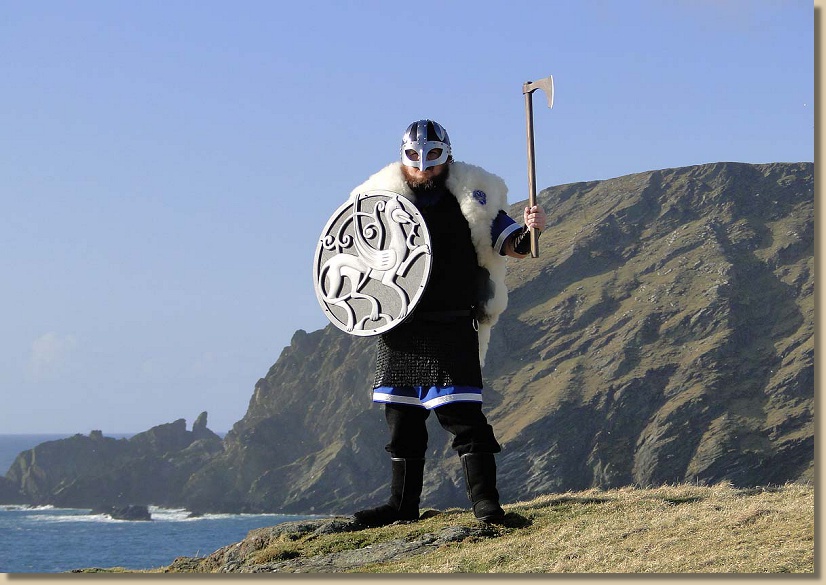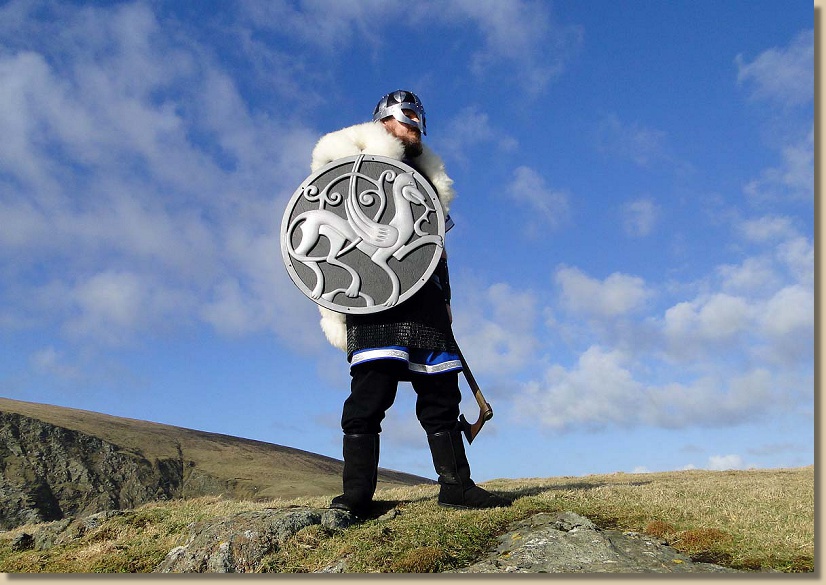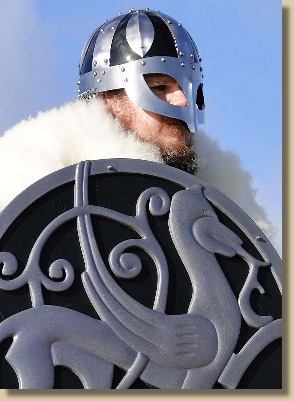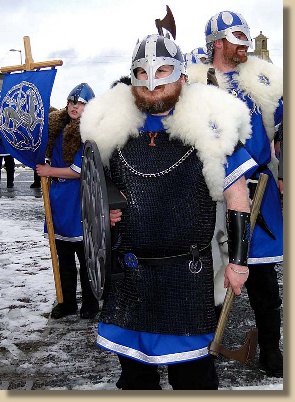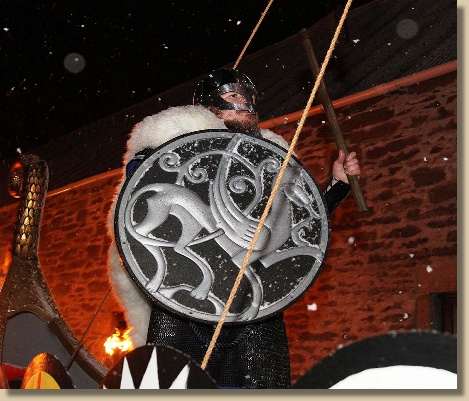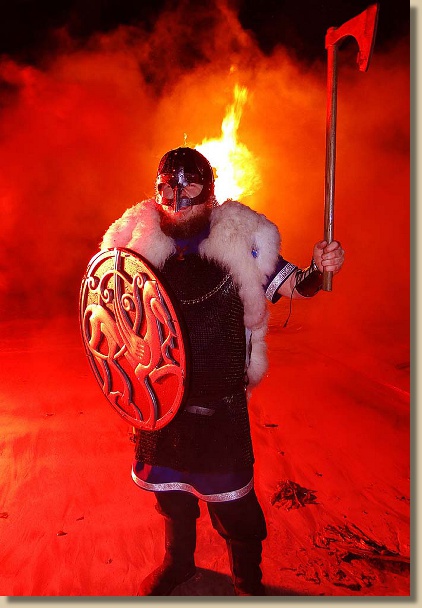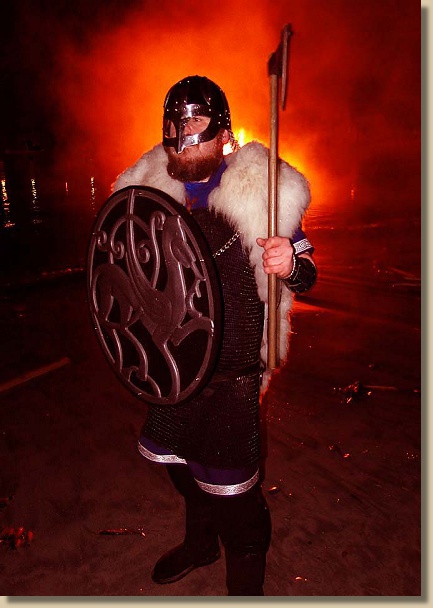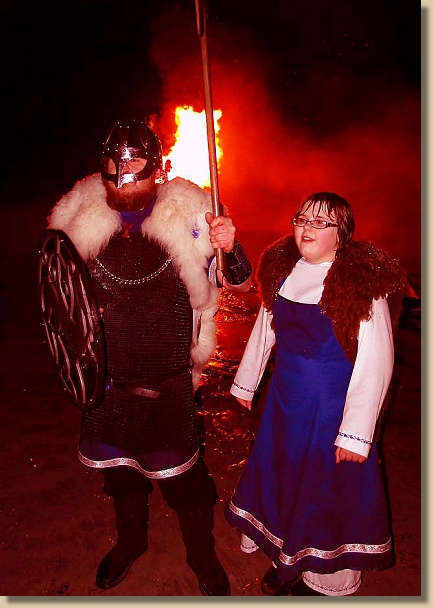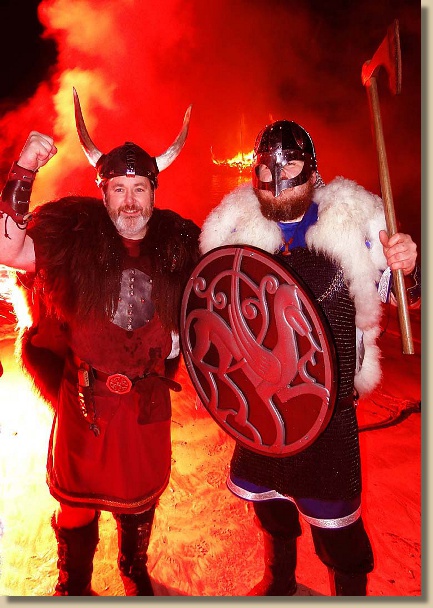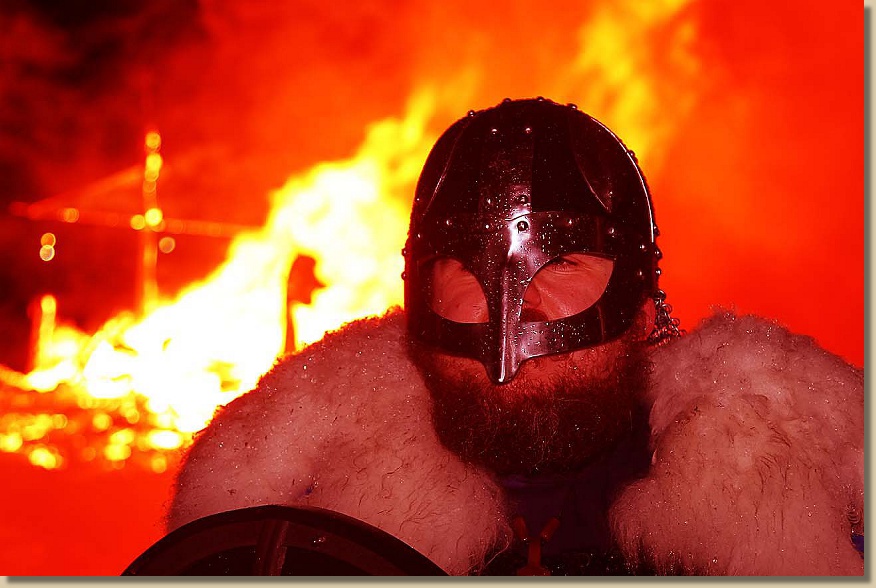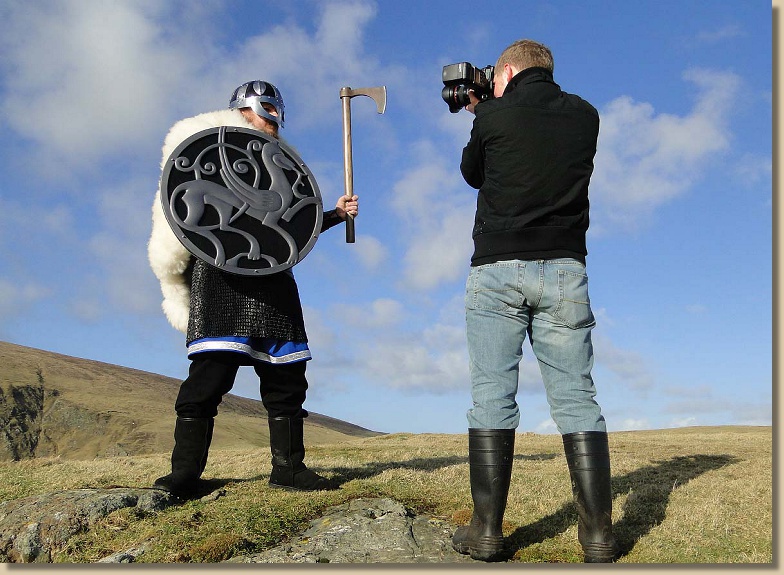|
|

















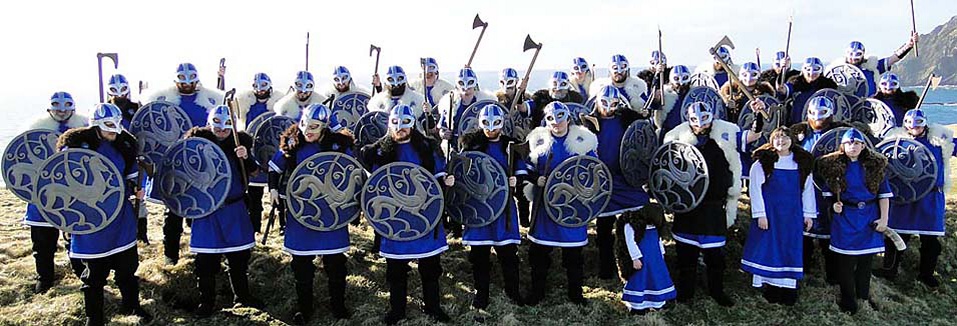

















2011 SMUHA Guizer Jarl - Brydon Robertson
Harald Maddadsson
Harald Maddadsson
The 2011 SMUHA Guizer Jarl Brydon Robertson
chose to portray one of the most significant but
complicated characters in the politics of the
Earldom of Orkney and Mormaer of Caithness.
Along with Sigurd Eystein's son and Earl
Thorfinn, Sigurd's son, Harald Maddad's son
was one of the three most powerful Earls of
Orkney as recorded in the Orkneyinga Saga. To
Joseph Anderson's edition of the Saga he is
described as: "...a mighty chief and a man of
large stature and great strength."
Known in Gaelic as Aralt mac Mataid, Harald Maddadsson was born in 1134 and was the son of Matad, Mormaer of Atholl and Margaret daughter of Earl Haakon Paulsson of Orkney, thus giving him both Gaelic and Norse lines of descent.
Written in the Orkneyinga Saga is the reported abdication but more likely the murder of Earl Paul Hakkonsson the then Earl of Orkney, possibly at the instigation of Margaret, Harald's mother, which lead to the Earldom passing to Rognvald Kali Kolsson. However, with the judicious intervention of both Matad and Margaret, backed by King David I of Scotland, Harald Maddadsson was appointed joint ruler in 1139 despite the fact that he was barely five years old. During those formative years control on Harald's behalf was exercised by councillors chosen by King David who ruled in conjunction with Earl Rognvald himself.
In the early 1150s, either '50 or '51, Harald visited Norway with Earl Rognvald where he may have met with King Ingi Haraldsson and it was soon after this event that Earl Rognvald decided on his crusade to the Holy Land, he called a great meeting of all his chiefs residing in his dominions,
Known in Gaelic as Aralt mac Mataid, Harald Maddadsson was born in 1134 and was the son of Matad, Mormaer of Atholl and Margaret daughter of Earl Haakon Paulsson of Orkney, thus giving him both Gaelic and Norse lines of descent.
Written in the Orkneyinga Saga is the reported abdication but more likely the murder of Earl Paul Hakkonsson the then Earl of Orkney, possibly at the instigation of Margaret, Harald's mother, which lead to the Earldom passing to Rognvald Kali Kolsson. However, with the judicious intervention of both Matad and Margaret, backed by King David I of Scotland, Harald Maddadsson was appointed joint ruler in 1139 despite the fact that he was barely five years old. During those formative years control on Harald's behalf was exercised by councillors chosen by King David who ruled in conjunction with Earl Rognvald himself.
In the early 1150s, either '50 or '51, Harald visited Norway with Earl Rognvald where he may have met with King Ingi Haraldsson and it was soon after this event that Earl Rognvald decided on his crusade to the Holy Land, he called a great meeting of all his chiefs residing in his dominions,
Despite his strength and his followers confidence in his leadership soon
after Earl Rognvald's departure, Harald faced his first test and fared rather
badly. King Eystein Haraldsson of Norway raided the Earldom of Orkney
and captured Harald who was only released on the payment of a ransom
in gold and the promise of allegiance to Eystein.
With the deaths of several prominent and influential Earls and also King David himself, Harald found by 1158 he was the undisputed Earl of Orkney and neither the Kings of Scotland or Norway were strong enough to dispute his title. With this power Harald pursued his own policies one of which was not to directly support the Kings of Scotland.
As was the practice in Moray and Ross and Cromarty, lands were being ceded to Scots or Scotto-Norman nobles and with the allocation of land by King William to Harald the Younger, grandson of Rognvald Koli, this lead to inevitable conflict between the King and Harald Maddadsson. During this period of conflict and in the ebb and flow of battles, Harald lost but re-took Caithness.
Harald's problems were not confined to Caithness. His brother-in-law Olaf fought with the Oyskeggs (Orkney and Shetland warriors) against King Sverre Sigurdsson of Norway but faced defeat at the battle of Florvag. King Sverre, thinking that Harald was behind this action seized Shetland which was never returned in Harald's life-time.
Harald's turbulent life ended in 1206 when he died of natural causes, but not before he gained some solace for the most gruesome event in his life. In 1202 Pope Innocent was persuaded that Harald had not been responsible for the torture and mutilation of Bishop of John Caithness but it had been Harald's kinsman and servant Lumberd and so he was suitably punished.
Harald Maddadsson was married twice; his first wife Afreka (Affirca) bore him four children, Heinrek, Hakon, Helena and Margaret. His second wife was Hvarflod, daughter of the Earl Mael Colium of Moray. Married around 1168 they had six children; Thorfinn, David, Jon, Gunnhild, Herborga and Langlif. David and Jon went on to be joint Earls of Orkney while Heinrik ruled in Ross.
With the deaths of several prominent and influential Earls and also King David himself, Harald found by 1158 he was the undisputed Earl of Orkney and neither the Kings of Scotland or Norway were strong enough to dispute his title. With this power Harald pursued his own policies one of which was not to directly support the Kings of Scotland.
As was the practice in Moray and Ross and Cromarty, lands were being ceded to Scots or Scotto-Norman nobles and with the allocation of land by King William to Harald the Younger, grandson of Rognvald Koli, this lead to inevitable conflict between the King and Harald Maddadsson. During this period of conflict and in the ebb and flow of battles, Harald lost but re-took Caithness.
Harald's problems were not confined to Caithness. His brother-in-law Olaf fought with the Oyskeggs (Orkney and Shetland warriors) against King Sverre Sigurdsson of Norway but faced defeat at the battle of Florvag. King Sverre, thinking that Harald was behind this action seized Shetland which was never returned in Harald's life-time.
Harald's turbulent life ended in 1206 when he died of natural causes, but not before he gained some solace for the most gruesome event in his life. In 1202 Pope Innocent was persuaded that Harald had not been responsible for the torture and mutilation of Bishop of John Caithness but it had been Harald's kinsman and servant Lumberd and so he was suitably punished.
Harald Maddadsson was married twice; his first wife Afreka (Affirca) bore him four children, Heinrek, Hakon, Helena and Margaret. His second wife was Hvarflod, daughter of the Earl Mael Colium of Moray. Married around 1168 they had six children; Thorfinn, David, Jon, Gunnhild, Herborga and Langlif. David and Jon went on to be joint Earls of Orkney while Heinrik ruled in Ross.
He made it know to them that he intended to leave Orkney and go to Jorsalaheim (Jerusalem), saying that he would leave the
government in the hands of his kinsman Harald and praying all his friends to obey him, and help him faithfully in whatever he
required while he was obliged to be away himself. Earl Harald was then nearly twenty, tall and strong, yet he was a wise man and
the people thought he would be a good chief.
